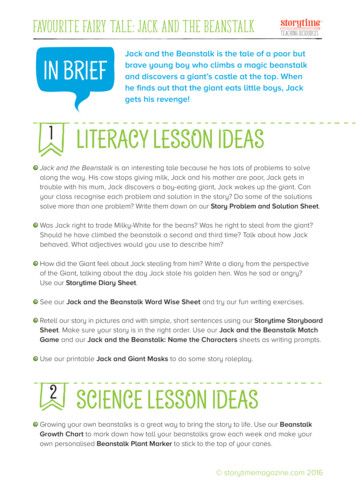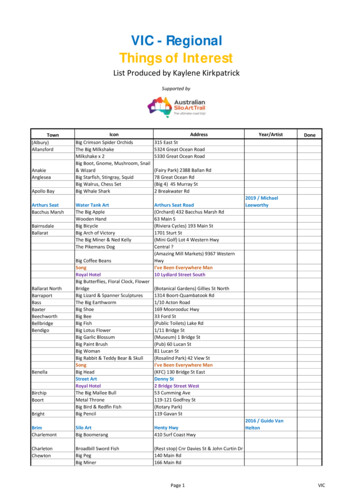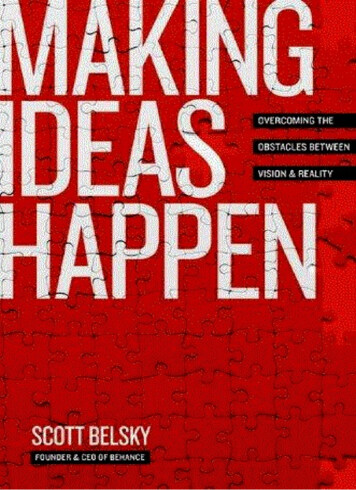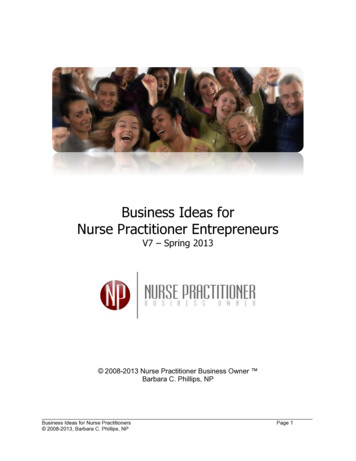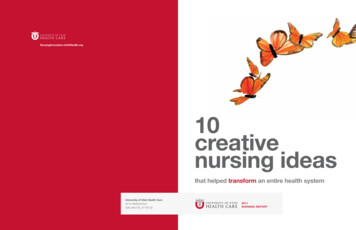
Transcription
Wendy WoodINSIDE THE BIG IDEASGood Habits, Bad Habits: The Science ofMaking Positive Changes That StickWendy Wood
ABOUT THE AUTHORWENDY WOOD IS A RESEARCH PSYCHOLOGISTwho has devoted the last 30 years to understandinghow habits work. After completing her graduate degree in psychology at the University of Massachusetts, she went on to be the James B. Duke Professorof Psychology and Neuroscience at Duke University.Currently, she is Provost Professor of Psychologyand Business at the University of Southern California,where she also served as Vice Dean of Social Sciences.A 2008 Radcliffe Institute Fellow, and the 2018 Distinguished Chair of Behavioral Science at the Sorbonne/INSEAD in Paris, Wendy has advised the World Bank,the Centers for Disease Control, and companies suchas Proctor & Gamble and Lever Brothers. The author ofover 100 scientific articles, she has received numerousawards for her research and teaching. For the lastthree decades, her research has been continuouslyfunded by the National Science Foundation, the National Institute of Health, and the Templeton Foundation.
A LETTER FROM ADAM GRANTDear NBIC Member,As long as I can remember, I’ve had a habit of being late for pretty much everything: meetings, phone calls, weddings. It drives my colleagues—and my wife—crazy. Ask me why, and I can rattle off a list of reasons. I have a chronic inabilityto disengage from my current task until it’s done. Clock time is an arbitrarysocial construction, like township borders, dress codes, and not ending sentenceswith prepositions. I’m determined to use every minute productively. Yep, theseare explanations, not excuses.It wasn’t until I read Good Habits, Bad Habits that I understood how I formedthis habit—and how it persists alongside my habit of finishing projects ahead ofschedule.Wendy Wood is the world’s leading expert on habits, and as a widely respectedpsychologist, she’s spent much of her career studying how we can make themand break them. Her vibrant writing challenges conventional wisdom and takesyou on a tour of the evidence on how to make behavior change stick.In the spirit of candor, her book hasn’t stopped me from being late. But it hashelped me show up late less often (and with better justifications). I’d tell youmore, but I’m due for a call, and I’m dialing in early. Don’t get used to it.All the best,Adam Grant
INTRODUCTIONWhen it comes to making and breaking habits, conventional wisdom is that thekey to success is willpower. If you want something badly enough, then you’ve justgot to keep at it. If you don’t get the results you want, it’s because you gave up.Your commitment to change wavered.But according to Wendy Wood, University of Southern California Professorof Psychology and Business and the leading scientist on the nature of habit,conventional wisdom is all wrong. Wood has spent decades researching dailyexperiences and habits, only to conclude that willpower and determination havelittle to do with successful habit change.White-knuckling temptation, in fact, is a scientifically proven path to failure.And those “high control” super-achievers that seem to effortlessly resist temptation—they aren’t actually using more self-control than the ordinary person.Instead, they’re replacing self-control with habits. By automating their desiredbehavior, they’re creating the persistence they need to achieve their goals.In Good Habits, Bad Habits, Wendy Wood provides the first scientificallygrounded analysis of habit formation. Drawing on her extensive research, Woodexplains the complex processes behind habits, diving deep into the three basesfor habit formation: context, repetition, and reward. She goes on to provide atoolkit for how to get rid of old, unwanted habits and how to create new, desiredones. Surprising, practical, and accessible, Good Habits, Bad Habits reveals how toform habits that work with us, not against us—and make real change in both ourpersonal and professional lives.Read on for 10 Big Ideas from Good Habits, Bad Habits. And be sure to visit theNext Big Idea Club Member Library to view exclusive Insight Videos featuringauthor Wendy Wood.
INSIDE THE BIG IDEASGOOD HABITS, BAD HABITSWENDY WOOD10 BIG IDEAS FROM GOOD HABITS, BAD HABITS1) The invisibility of habit hides its enormous power over our lives.Before learning how to promote good habits and break bad ones, it helps tounderstand exactly what habits are, and how they function in our lives.Habits are actions that are performed automatically, without conscious direction.Whether it’s brushing your teeth, sending a follow-up email, or pulling out acredit card at the cash register, the range of behaviors that can be classified ashabitual is quite broad. Using a research technique called experience sampling, inwhich participants report on what they are doing as they are doing it, Wood rana study with a group of students at Texas A&M University to investigate thenature of habitual behavior. Every hour, a wristwatch alarm alerted students, whowould stop and write down what they were doing and thinking. Based on theseresults, as well as a follow up study with a larger group, Wood and her team determined that a staggering 43 percent of behaviors were performed out of habit.Habit refers to how you perform an action, not what the action is. The keyfeature of habits is that they work outside of your conscious awareness, so it’seasy to overlook their presence in your life. This is especially true when it comesto desirable habits. Usually we notice habits that we don’t want—overspending,biting our nails, binge-watching TV shows late at night—whereas the habitsthat we welcome either go unnoticed or are attributed to our conscious selves.We assume that, out of love for our children, we read to them before bed everynight, or that out of safety concerns, we buckle our seat belts whenever we getin the car. Psychologists call this over-confidence in our thoughts, feelings, andintentions the introspection illusion. This tendency to overestimate the extent towhich our actions depend on our internal states is a self-flattering myth.And while this distinction might not seem important, there is, in fact, a hugedownside to our conscious mind taking the credit for our unconscious, habitualself—it keeps us from exploiting this hidden resource. Until we acknowledge ourhabits, both good and bad, our habitual self will remain a silent partner, full ofpotential energy but never asked to perform to the fullest.2) Context is king.The first basis of habit formation is context. Context refers to all of the externalforces that serve to either restrain or drive your actions. Restraining forces increase the friction on something (for example, tobacco laws that hindersmoking), whereas driving forces encourage the behavior (for example, seeing
another person light a cigarette). While internal forces—such as goals, feelings,and attitudes—do exert an influence, when it comes to driving or restraining ouractions, the contexts around us are exceedingly powerful.There is perhaps no easier context we can manipulate than proximity. Simplyput, we engage with what is near us, and tend to overlook what is far away.Controlled lab experiments and studies have shown that proximity influenceseverything from what you eat to what you buy to who your friends are. It evenaffects whether or not you’ll go to the gym.In 2017, a data analytics company reviewed cell phone records from 7.5 milliondevices, analyzing how far people with mobile devices traveled to paid fitnesscenters. People who traveled a median distance of 3.7 miles to the gym went fivetimes or more every month. Those who traveled around 5.1 miles went just oncea month. All it took was a tiny difference, less than a mile and a half, to separatethose who had an exercise habit and those who went rarely.So instead of beating yourself up when you fail to will yourself healthier, orwealthier, or wiser, simply change your surroundings. Rearrange your kitchen.Avoid that well-meaning coworker who always brings in brownies. Take a routeto the office that avoids the coffee shop with the 20-ounce Frappuccinos. Makeyour life easier by addressing the contexts in which you live. Remove the friction,establish the right driving forces, and let the good habits roll into your life.3) The truth about repetition.The second basis of habit formation is repetition. How many times, exactly, do youneed to repeat an action before it becomes automatic? The popular idea that it takes21 days to form a habit is, unfortunately, a myth. The real story is more complicated.In a three-month study conducted in Wood’s lab, a postdoctoral researcher tested how many times actions have to be repeated until they feel automatic. Eachparticipant named a new healthy behavior that they wanted to perform regularly.One person, for example, decided to eat a piece of fruit every day at lunch.Another chose to run for fifteen minutes right before dinner. At the end of eachday, participants logged whether or not they had performed as planned, as well ashow automatic the behavior felt to them.The results? For eating something healthy, participants had to repeat the actionfor about sixty-five days before they did it mostly without thinking. Having ahealthy drink (for example, a bottle of water with lunch) took only fifty-ninedays. Exercise took the longest, with ninety-one days of repeated action required
INSIDE THE BIG IDEASGOOD HABITS, BAD HABITSWENDY WOODfor the action to become largely habitual. On average, it took participants sixty-fivedays of repeating a simple health behavior until they experienced it as automatic.While two months plus a week may sound challenging, there’s a reassuring discovery that comes along with that sixty-five day number: Participants could missa day or two without derailing what they had started. The day they began again,automaticity was almost as high as when they lapsed. This is a crucial finding—you can miss a day or two, and you will not be set back to zero. So wherever youare on your sixty-five day journey, don’t despair if you miss a day. Instead, use itas an opportunity to make your context tighter, stronger, and clearer. Your habitis still forming.4) How rewards work.The third and final basis of habit formation is reward. Context will smooth theway and repetition will jump-start the engine, but if you aren’t getting even aminor reward for your initial efforts, you’ll never get the habit to start operatingon its own.For rewards to be effective in habit formation, they need to be bigger and betterthan what you would normally experience. This is because unexpected rewards spurthe immediate release of dopamine, a neurotransmitter often called the “feel-goodchemical” because it is involved in our experience of rewards. Although science isstill discovering much about neuronal timing, dopamine seems to promote habit-learning for less than a minute. Rewards in the future, such as a paycheck bonusin two weeks or an athletic trophy at the end of the season, will not change neuralconnections in the same way. Rewards have to be experienced right after we dosomething in order to build habit associations in memory.Given this timing, the most effective habit-building rewards are often intrinsicto a behavior, usually feelings of pleasure or satisfaction. A study examiningexercise habits among college students showed that, predictably, those who ratedexercise as a fun activity that made them feel good exercised more often andreported that it was more habitual and automatic. What’s particularly interesting,however, is that students who exercised just as often, but who indicated that theywent mostly out of guilt or to please others, failed to form a robust habit. Theyhad to keep consciously making themselves go to the gym or track, without ahelpful habit taking over.Eventually, of course, rewards diminish. For scientists, insensitivity to rewardis the gold standard for identifying a habit. The only way to know for sure if anaction is habitual is to test what happens when the reward changes. If we persisteven when we don’t value the reward as much, or the reward isn’t as available,
then it’s a habit. The waning of rewards’ effect explains why our newfoundfrugality persists long after our credit card debt is paid off, and the pride ofsaving money is a distant memory—our behavior is now on autopilot. Even thevery wealthy can get stuck with frugal habits like this. Warren Buffett, chair andCEO of Berkshire Hathaway and one of the richest people in the world, lives inthe same home he bought for 31,500 in 1958.So remember: habits are built in the moment, from our experience of pleasure.We learn habitually when our actions repeatedly bring us more pleasure than ourneural systems expect.5) The perils of variety, and the importance of timing.Habits, as we have seen, thrive on reward uncertainty. Beyond this, habits don’tcrave variety—in fact, they hate it. Variety weakens habit because variety is theenemy of stable contexts. If you aren’t arranging your life to reliably, unfailinglycue your new desired habit, then that habit will never take hold. Only by keepingyour life as consistent as possible will your habit grow.When it comes to bolstering consistency, one of the most powerful contextcues is time of day. Over twelve weeks, new gym members in a study developedpatterns of exercising at regular times. One reported going every morning at 7:00a.m., and another went daily after dinner. Others reported that they exercisedwhenever they could find time. At the end of the study, those who exercised atthe same times of day reported that they did so without thinking much about itor reminding themselves to go. For them, exercise had become automated. Thosewho worked out at inconsistent times weren’t so lucky. They seemed to have torely on that old model, exercising only when they wanted to, or when they consciously forced themselves to go.Timing also matters when we need to take regular medications. A particularlyconvincing study tested the advantage of time cues for taking oral contraceptives.About half of the participants admitted that they missed doses each month.Among those who missed twice or more a month, only 44 percent had a regulartime to take their meds, whereas 90 percent of those who never missed a doseused time cues. It didn’t matter when they took the pills—morning, afternoon,evening, or night. Just doing it at the same time was critical.To our conscious minds, stable cues aren’t a big deal—taking pills at differenttimes of day shouldn’t matter if you’re sufficiently motivated. Yet patient beliefshad no impact on repeated medication compliance. Stable time cues, not motivation, were what kept patients compliant.
INSIDE THE BIG IDEASGOOD HABITS, BAD HABITSWENDY WOOD6) Skip a step with habit stacking.One especially useful technique from the realm of context consistency is called stacking.Stacking involves tying a new behavior to existing cues for an established behavior.Fire-prevention associations have successfully used this technique for years, campaigning to get people to change their smoke alarm batteries when they changetheir clocks to and from daylight saving time. We can stack, or piggyback, the behavior of replacing batteries on top of adjusting our clocks. The existing behavioris the stable context—you have to do it twice a year. With practice, everythinggets cued together: change clocks, replace batteries.Tying a new behavior to existing cues is a useful life hack for forming a newhabit. The new behavior quickly becomes automated because the automaticity isalready in place—you just have to add a new step.For more evidence that stacking works, consider flossing. Many of us brushour teeth regularly, but fail to floss. To test whether stacking increases flossing,researchers gave fifty British participants, who flossed on average only 1.5 timesper month, information encouraging them to do it more regularly. Half of the participants were told to floss before they brushed at night, and half after they brushed.Note that only half of the participants were really stacking—using an existingautomated response (brushing their teeth) as a cue for a new behavior (flossing).The other half, who first flossed and then brushed, had no automated cue.At the end of the month, all participants had flossed, on average, about twenty-four days. Eight months later, however, those who stacked—flossing afterthey brushed—were still doing it about eleven days a month. For them, the newbehavior was maintained by the existing habit. The group originally instructed tofloss before they brushed ended up doing it only about once a week.As a business strategy, stacking is sometimes called piggyback marketing. Twodifferent companies team up so that the carrier company’s existing product becomes a cue to use a rider company’s complementary one. Piggyback marketingexplains how PayPal so quickly gained in popularity, as it was integrated intoeBay very early on. While people were making eBay purchases, they got used toseeing and using PayPal, thereby developing a PayPal habit to go with their eBayhabit. And then that PayPal habit extended beyond eBay purchases.Stacking is most successful when the new behavior is compatible with an existing habit. Want to take your meds at night? Put them on your nightstand andtake them when checking your phone before bed. If you head out of the office
at 10:00 a.m. to get a coffee at Starbucks, make that the time you answer at leastone email you’ve been putting off. The cues will stack, and soon enough, the painof answering a difficult email will fold into the reward of the coffee—presto, youhave a brand new integrated habit.7) The surprising power of situational control.Harnessing friction is a great way to increase our effectiveness, but how do wecontrol the friction of our own behavior? One of the best strategies is not to takeit on directly—instead, focus on the situation.Angela Duckworth and her fellow researchers asked a group of University ofPennsylvania undergraduates to list academic goals, such as “study French for anhour every night.” For a week, some of these students were instructed to modifytheir study spaces to minimize temptation: setting reminders or alarms, installingonline apps to block distractions like Facebook, or reserving study carrels in thelibrary. A second group of students was told to rely solely on willpower and theirability to resist temptation.At the end of the week, students rated themselves on a scale from 1 (extremelypoorly) to 5 (extremely well) for how successful they were at meeting their studygoal. Those controlling their situations scored about half a scale point better thanthose who tried to simply buckle down with self-control.Multiple studies confirm that behavior change through self-control isn’t assuccessful as behavior change through altering contexts. Even if it were equallyeffective (which it’s not), controlling our actions simply isn’t fun. It means wehave to continually fight our desires, remaining eternally vigilant, wretchedlystopping ourselves from doing what keeps coming to mind.In the study, Penn students who changed their study spaces were not in thisunhappy state of war with themselves. After adjusting their surroundings toremove distractions and temptations, students said they didn’t experience manyunwanted desires. They were not, for example, torn between watching a moviewith friends or studying for a test. They had put themselves in the library, whereno such alluring possibility existed. They didn’t have to consciously force themselves to do the right thing. Instead, they did what was easiest in that environment—study. They didn’t have to conquer themselves and deny their urges. Theydidn’t have to be wet blankets, because they had no fire to put out.Once in place, the forces in our environment continue to cue us to achieve ourgoals. We can ignore them or take them for granted, but they are still automating
INSIDE THE BIG IDEASGOOD HABITS, BAD HABITSWENDY WOODour behavior long after we have forgotten them. And yet, many of us discountthe important role that such forces play in our behavior. Instead, we remain inthe trenches, fighting to stay motivated and to exert control.8) What French cooking can teach you about habits.Mise en place is French for “put in place,” an idea that permeates professionalkitchens. Chefs don’t start cooking until everything is, literally, in place: theirimplements at the ready, ingredients measured and chopped, and items orderedas they will be used in the recipe. Mise en place reduces friction in the kitchen. Itremoves the restraining forces that get in the way of making a recipe, and sets upthe driving forces to cue it automatically.Students at the Culinary Institute of America learn this deceptively simpleconcept on the first day of class, but it’s a principle that has power beyond thekitchen. As a former professional chef explained to Wood, he uses mise en placeat his new job as a teacher, getting everything in order the night before: fromsetting up the roster, to organizing all of his materials, to establishing a timelinefor every upcoming task.If this sounds like a lot of work for your executive, conscious mind, it is. This level of preparation requires calling on that part of ourselves that projects forward,that plans, that sees patterns, anticipates failures, addresses weaknesses, and designs stopgaps. But while the starting position for some of your most successfulhabit formations will be highly rational and call on your conscious self, the benefit of the habitual self is that it builds on that starting position, and eventuallyremoves the need for continuing attention. A lot of up-front investment pays offwith passive returns for all time.9) Self-control isn’t what it looks like.People who report having a high level of “self-control” are often especially effective at achieving health, wealth, and happiness. As it turns out, however, these individuals don’t attain their admirable outcomes in the expected way—by activelyexerting willpower. Their success is not due to some superhuman ability to resisturges and inhibit unwanted actions. People who score high on “self-control”scales aren’t using control at all, but forming habits to automate their behavior. Inshort, habits make it easy to accomplish their goals.The talents of high “self-control” people extend beyond just knowing how toform beneficial habits. They also seem to understand how to put themselves intocontexts with the right forces to achieve their goals, taking advantage of contextcues and engaging situational control. For example, in an online survey, individ-
uals who scored high on a “self-control” scale also agreed with statements like “Ichoose friends who keep me on track to accomplishing my long-term goals,” and“When I work or study, I deliberately seek out a place with no distractions.”As you set out to develop new habits, you’re going to quickly re-discover somethingthat you intuitively knew in advance: the greatest source of friction in this world isother people. They are both helpful and detrimental influences on our desired selves.People with high “self-control” not only know this, but also act on it. College students in one study chose one of two partners to work with on a task (actually, experimental accomplices). “Alex” was supposedly undecided on his major, spent hisspare time playing video games and partying, and mostly slept late during winterbreak. “Taylor” was a premed student with a part-time job who volunteered at ananimal shelter and studied during winter break. Participants who had earlier scoredhigh on “self-control” mostly wanted go-getter Taylor as a work partner, whereaslow scorers were equally likely to select Alex the slacker or Taylor the achiever.Not everyone recognizes the way our environments influence us. But like theUniversity of Pennsylvania students, we can all start to benefit from this insight,and acquire the trained eye of someone high in “self-control.”10) Happiness and the mindfulness habit.Many of us are guilty of overthinking things, generating anxiety and preventingourselves from getting anything done. And in recent years, a new appreciation for“mindfulness” has cropped up as an attempted solution to this “overthinking” menace.But it turns out that minding our habits is perhaps the most natural and effectivepath to inner calm. A habitual mind is a benignly thoughtless mind. It is a mindthat sorts tasks into their proper places. It is not obsessed with figuring out whenyou fall asleep; instead, it just responds to the sleep cues in your context, and youdrift right off.Acting habitually has broader effects as well, reducing uncertainty and promoting feelings of coherence and comprehension of our experience. In a survey ofdaily routines, people who reported that they do “pretty much the same thingsevery day” found life more meaningful. When contacted during their day, peoplereported more meaning in life when performing actions that were part of aroutine. It turns out that we can discover meaning in life by simply maintaininga tidy office, keeping a daily schedule, having weekly dinners with friends, orwalking the same path to work or school every day. This is the coherence of anordered life. And it’s a coherence attainable by all of us.
INSIDE THE BIG IDEASGOOD HABITS, BAD HABITSWENDY WOODTALKING POINTSShareable Stories, Facts, and Figures from Good Habits, Bad HabitsStudies have shown that, on average, 43 percent of the time our actions arehabitual, performed without conscious thought. These activities include dailyhygiene (88 percent), tasks at work (55 percent), exercise (44 percent)—evenresting, relaxing, and sitting on the couch were performed habitually much of thetime (48 percent).If you ever feel like you aren’t very aware of your habits, and would like to be,here’s a simple trick: go public. Just being around other people is usually enoughto turn the spotlight inward and to start to monitor what you ordinarily woulddo without much scrutiny.We often underestimate the benefits of persistence, especially when it comesto creativity. Multiple studies involving creative tasks have shown that whileparticipants expect decreasing returns for their continued efforts, when specifically instructed to persist (for example, comedians who were told to generateadditional funny endings to sketches), they generated not only more solutionsthan anticipated, but also more creative ones. In contrast to the comedians’expectations, independent evaluators rated the solutions generated at the end ofthe session as more creative than the ones produced initially.One of the reasons we don’t know much about our own habits is that theyaren’t accessible to consciousness. When we repeatedly do the same thing thesame way, our brains store these automatic scripts, called procedural memory,somewhat separately from other memory systems. This kind of cognitive codingis a sort of mental equivalent of admin-only files on your computer.Acting based on habits has the additional benefit of freeing our consciousmind to do other tasks. This is why both Barack Obama and Mark Zuckerbergwore almost the same thing every day (Obama wore a blue or gray suit, Zuckerberg a gray t-shirt). Each identified a wardrobe choice that fit their position, andthen stuck with it, thus avoiding the distracting, conscious choices about what towear every day.You might think you’re eating because you’re still hungry, but studies have shownthat we eat in response to available cues: as long as there’s food on our plate,we keep going. In a cafeteria study, patrons on several days got the standardserving of pasta and cheese (1,800 calories) and consumed almost all of it (1,700
calories, on average). On other days, researchers had the cafeteria increase the portion so that the dish was 50 percent larger (2,600 calories). As a result, patrons ate43 percent more (2,400 calories). When surveyed after the meal, all patrons judgedthat the amount they ate was comparable to the amount they usually ate for lunch.They also said that the servings were the appropriate size for them.When it comes to forming and breaking habits, willpower isn’t much help—especially when stacked up against nicotine. The Centers for Disease Controlreport that 68 percent of smokers say they want to quit completely. However,each individual attempt usually fails. Only about one in ten attempts to stopsmoking for good succeeds. Most people end up relapsing, typically within aweek. To quit successfully can take thirty or more attempts.A common strategy for building new behaviors onto existing cues involvesswapping one behavior for another. The habit cues that automatically activatedan old response can be co-opted to activate a new, similar response. Swapping explains the immediate popularity of soy milk—without much thought,lactose-intolerant consumers started to use it as a substitute for cow milk. Tofuhad a rockier start in U.S. markets—it could not easily be integrated into standard American recipes because it did not cook like animal proteins or cheese.(Eventually, tofu was incorporated into ice cream and gained some popularity asa dairy substitute.)Habits are strong under stress. Contrary to popular belief, habits aren’t challenged when they encounter stress. Just the opposite: after a habit has beenformed, stress activates it. Just keep in mind that this applies to both good andbad habits.
INSIDE THE BIG IDEASGOOD HABITS, BAD HABITSWENDY WOODINTERACTIVE: CREATE YOUR NEW HABITIt’s time to put what you’ve learned into practice! First, make a list of three newdaily habits that you’d like to develop:Habit 1:Habit 2:Habit 3:Now for each of these habits, think of an existing habit that you can easily attachit to. For example, say you’d like to start running every morning. Without toomuch trouble, you could “stack” that new
10 BIG IDEAS FROM GOOD HABITS, BAD HABITS 1) The invisibility of habit hides its enormous power over our lives. Before learning how to promote good habits and break bad ones, it helps to understand exactly what habits are, and how they function in our lives. Habits are actions that are performed automatically, without conscious direction.




